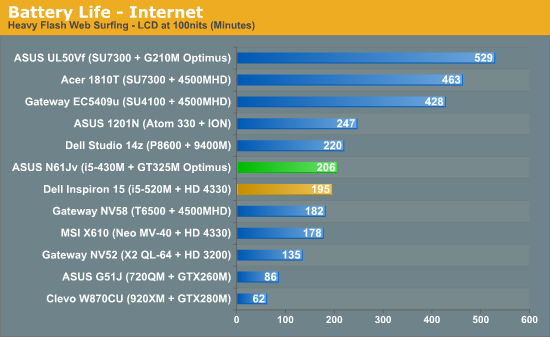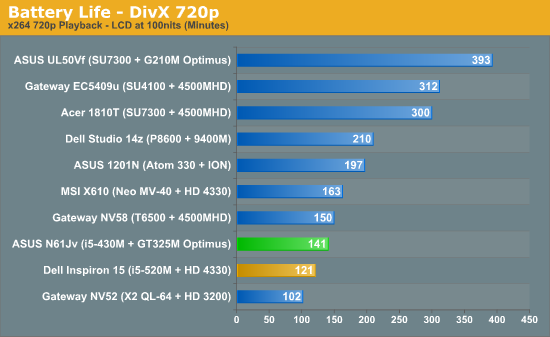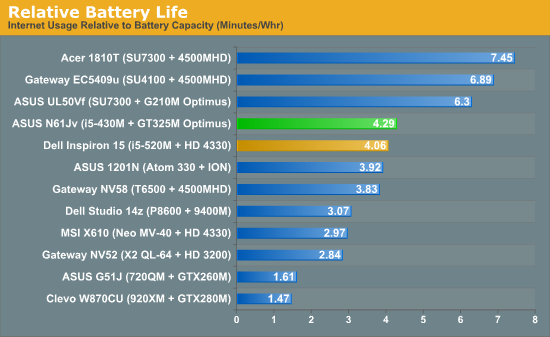ASUS N61Jv-X2: Optimus GT325M Meets Arrandale
by Jarred Walton on March 13, 2010 10:00 PM ESTASUS N61Jv-X2 Battery Life
Like the Dell Inspiron 1564, the N61Jv comes with a 6-cell, 48Wh battery. ASUS doesn't specify a battery life for the N61Jv (that we could find), but users are reporting up to four hours of battery life in light loads and around two hours for movies. We calibrated the display for ~100nits (a setting of 41% results in 94nits brightness) and ran our standard battery life tests.





The battery life of the ASUS N61Jv is very similar to the Inspiron 1564, but it lasts 5-15% longer depending on the task. Video playback results favor the N61Jv more than the idle/internet tests, which is interesting since all of these tests use the Intel HD Graphics in the i5 CPU. Of course, the N61Jv battery life pales in comparison to CULV offerings, which can last more than twice as long. If you want a long-life mobile solution, the N61Jv isn't a great choice, but by the same token you can't come anywhere near the performance of the N61Jv with a netbook or CULV platform.
Looking at the relative battery life does provide a bright spot in an otherwise ho-hum set of charts: the N61Jv with i5-430M provides 12% better battery life than a previous generation Core 2 Duo + 4500MHD combination. In fact, the only laptops that provide better relative battery life are CULV designs (and Atom, though we didn't include Atom results in this review as netbooks are in a completely different classification). If ASUS had included a 65Wh battery, the N61J would be pushing into 5+ hour territory.










44 Comments
View All Comments
yyrkoon - Sunday, March 14, 2010 - link
It is about time you people at Anandtech implemented a black list for your comments section don't you think ?I know I am not the only one getting really *REALLY* bored with all the spam coming your way. Not to mention the ads you guys are seemingly letting in on your pages that peak CPU usage on modern PCs . . .
JarredWalton - Sunday, March 14, 2010 - link
I hear ya, and I'm probably one of the guys that deletes most of the posts. Thankfully we have an option to "delete all posts" by a user, but right now there's no quick way to ban a user as well. I'm hopeful we'll get that with the updated site in the next month or so.What I can't understand is the content of the spam we keep getting posted. Stupid fashion/clothing ads written in broken Engrish with no relation whatsoever to our content is a waste. Has *anyone* here actually clicked on any of the links? And yet they've created at least a dozen different accounts over the past few months, and they keep making new accounts.
Foggg - Sunday, March 14, 2010 - link
The advantages of the keyboard layout of the Asus over the Acer are:1) full size arrow keys, used far more than "0"
2) rt. Ctl key extends under the rt. Shift -- enabling selection by word or paragraph with just the right hand. Right index finger can hold down both, while other fingers hit the arrow keys. Great for editing.
IMO, the "0" key is pretty easy to adjust to, simply using the middle finger instead of the thumb.
JarredWalton - Sunday, March 14, 2010 - link
Having played with both, I find the Acer keyboard slightly more to my style. The smaller arrow keys don't bother me at all, as they're still big enough. Also, the smaller size helps set them apart from the other keys; notice how they're all in a perfect grid on the ASUS?For the CTRL+Shift, I almost always use my left hand for those keys, and I also use two fingers to hold down two keys. If I'm using CTRL and/or Shift + Arrow / End / PgUp / etc., all of the directional keys are on the right side so there's no way to comfortably hold CTRL+Shift+End with your right hand anyway (unless you have Gumby fingers).
I do understand that keyboards are a highly personal preference, so take my analysis with that in mind. It's not a huge difference, but I give Acer's layout the edge on this comparison.
fabarati - Sunday, March 14, 2010 - link
About your Criticism agains 5400 RPM Drives: the 500 GB 7200 RPM Seagate drives weren't all that fast, the first generation at least. The WD 500 GB 5400 RPM was generally as fast.yyrkoon - Sunday, March 14, 2010 - link
Any current 5400 RPM hard drive is going to be faster because of data density. A 7200 RPM drive with the same platter density will of course be faster. Name brand has little to do with that.teohhanhui - Sunday, March 14, 2010 - link
1366x768 at 16"? That immediately turned me away.utkal - Monday, March 15, 2010 - link
exactly...Its an another crap laptop with 1366x768 resolutionutkal - Monday, March 15, 2010 - link
EXACTLY !!!I do not understand why the hell Asus only hosts 1366x768 resolution lcds in their laptops. They have ONLY ONE laptop of full HD upto 16" screen size with a price of $1440 (approx) ! wtf ! In a 16" laptop what can be worst than this resolution lcd.
Sorry, but how AT reviewer said, we did not found anything bad about this laptop ? funny ! Do not you know the 1366x768 resolution makes the life hell if you use the laptop for work. Yes, if the laptop is bought ONLY TO GAME then its ok.
nortexoid - Monday, March 15, 2010 - link
Same